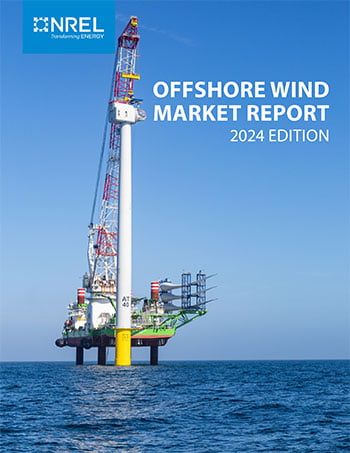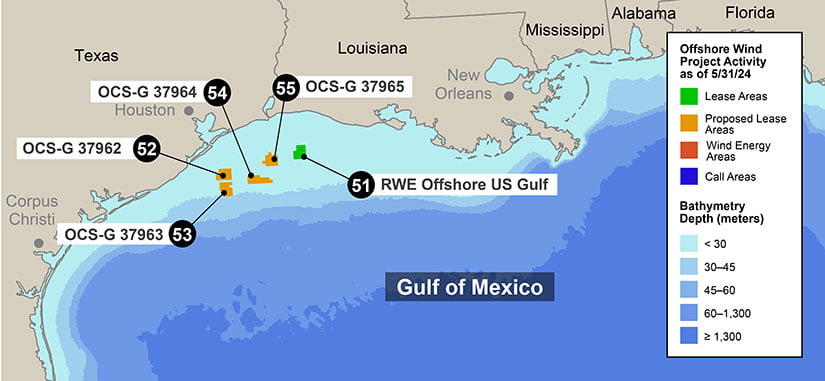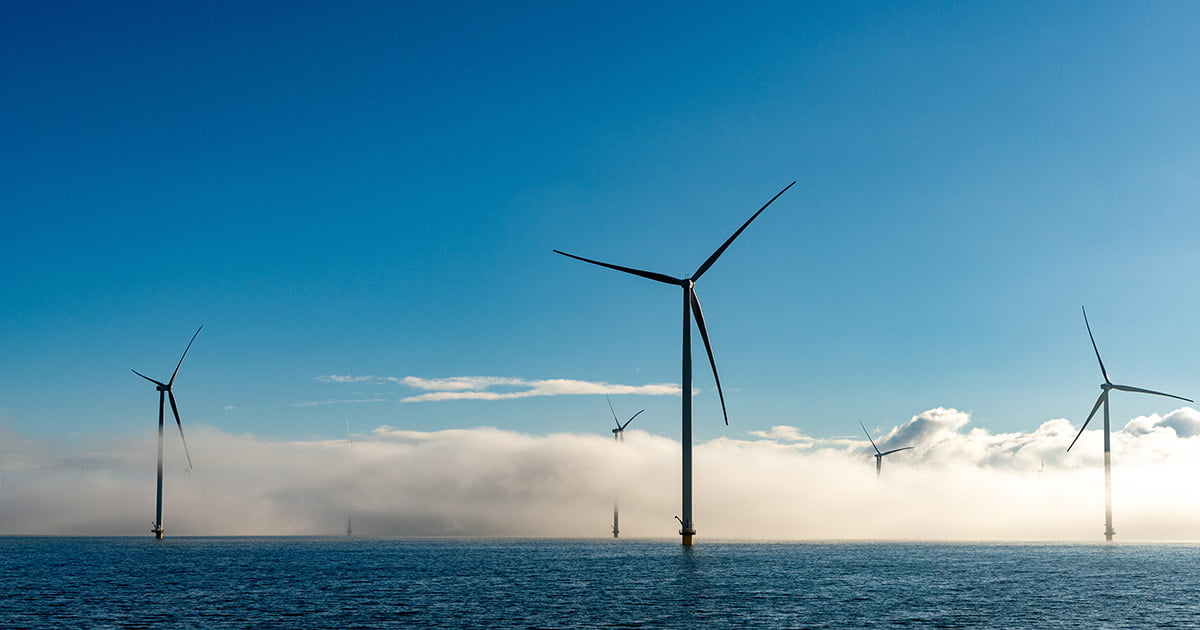“In the last year, we’ve seen a lot of projects exiting the permitting and regulatory pipeline and moving into the construction and operating phases,” said Walt Musial, NREL offshore wind energy expert and one of the report’s authors. “There are now thousands of megawatts of domestic projects being built, and we’re seeing the reality of all that regulatory planning and development turn into real projects.”
That is thanks, in part, to investments in port infrastructure and domestic supply chains, said Angel McCoy, senior offshore wind regulatory specialist at NREL and lead author of the report.
“The United States is positioning itself for homegrown offshore wind, from manufacturing to deployment to operations,” McCoy said. “Very early, offshore wind projects were contracting with international manufacturers and dealing with the challenges of getting parts and materials here. Now, investments are being made so that the infrastructure and supply chain components can be built here at home.”

All of this momentum was meticulously detailed in this year’s report, which NREL wind energy researchers produce annually on behalf of the US Department of Energy’s (DOE’s) Wind Energy Technologies Office. NREL researchers are tapped as authors because of their deep expertise in wind energy technologies and trends, supply chain and infrastructure development, and techno-economic analysis.
The Offshore Wind Market Report: 2024 Edition includes data on offshore wind energy projects in the global fleet through Dec. 31, 2023, and significant US domestic progress and events from Jan. 1, 2023, through May 31, 2024. The report, released by NREL, provides detailed information about offshore wind energy development to inform policymakers, researchers, and analysts about technology and market trends.
In Production or in the Pipeline
One of the biggest milestones mentioned in the report is the fact that the first commercial-scale offshore wind power plant in the United States, the 132-megawatt (MW) South Fork Wind Farm off Rhode Island, began delivering power to the Hamptons area of New York’s Long Island in November 2023. According to Musial, Hamptons residents chose the project because it was the least expensive way to get power to the area.
With a few other offshore wind farms in operation, as of May 31, 2024, there were 174 MW of US offshore wind power installed, equivalent to the amount of electricity needed to support more than 60,000 American homes. And much more power will soon head to shore.

A total of 4,097 MW of offshore wind energy was under construction as of the May 2024 report cutoff date—more than four times the previous report’s total. Three projects contribute to this total: Vineyard Wind I, which will send power to Massachusetts; Revolution Wind to Connecticut and Rhode Island; and Coastal Virginia Offshore Wind to Virginia.
Combined, the US offshore wind energy project development and operational pipeline reached a potential generating capacity of 80,523 MW, up 53% over the last report. Changes since the 2023 Edition of the report include:
- 132 MW of new offshore wind energy projects becoming operational
- 3,165 MW of new projects under construction
- 2,278 MW of new projects approved
- 25,172 MW of new lease area designations in the Gulf of Maine, Central Atlantic, Gulf of Mexico, and Oregon.
Taking a step back, researchers also identified solid gains in offshore wind energy deployment on a global scale. The total installed capacity was 68,258 MW worldwide as of Dec. 31, 2023, and the global generating capacity potential in the pipeline for all offshore wind energy projects reached 453,600 MW by the end of 2023 for both installed and planned projects.
State and Federal Support
Although the economic headwinds mentioned in last year’s report did result in the cancellation of several offshore wind energy projects, the majority of those projects are already being rebid with their respective state utilities.
“The response that the states had was to double down on their commitments to offshore wind,” Musial said. “We even saw the state of Maine adopt new policies to procure offshore wind. I think that’s a pretty positive signal.”
Eight states have set procurement mandates that total 45,730 MW of offshore wind capacity by 2040, according to NREL’s research. As of May 31, 2024, 15 contracts to purchase 12,378 MW of electricity from offshore wind power plants have been signed and are active around the country, capable of supporting the electrical needs of over 4 million American households.
In addition to state-level support, DOE estimates that $10 billion in federal funding has been announced or invested in the US offshore wind supply chain since the beginning of 2021, indicating a significant level of investor confidence in the US market.
Outlook for Floating Offshore Wind
Although the pipeline capacity for domestic floating offshore wind farms—which moor turbines to the seafloor in deeper (>60-meter) waters instead of being affixed to a foundation on the seafloor—is growing at a slower pace than fixed-bottom technologies, developers are looking to expand operations on the West Coast. The report notes that the US floating offshore wind energy market had approximately 25,116 MW of energy in the pipeline as of May 2024, which includes lease areas and proposed lease areas.
In April 2024, the Bureau of Ocean Energy Management released a leasing plan through 2028, including 12 offshore wind energy auctions—seven of which are in deep water and suited for floating offshore wind installations, which could accelerate floating offshore wind development.
“But we need to start small,” McCoy said. “Our floating technologies are not ready for ultradeep waters, meaning water depths that exceed 1,300 m, like those beyond 44 nautical miles off the coast of the Central Atlantic. We need to first demonstrate success in deep waters.”
Globally, floating offshore wind installations nearly doubled capacity in 2023, bringing the total to 231.4 MW.
Looking to the Future
The authors highlighted a few key market indicators that, when viewed together, point toward continued long-term growth. These include advancements in:
- Permitting
- Interconnection
- Commercial leasing
- State energy planning targets
- Procurement policies
- Offtake agreements
- Federal support for US jobs
- Supply chain development.
However, macroeconomic challenges, such as rising interest rates, supply chain constraints, and higher commodity prices during 2021–2023, have led to higher offshore wind energy costs globally and in the United States. These challenges will continue to affect projects planned for commercial operation between 2023 and 2026 and impact the levelized cost of energy from offshore wind, instilling more uncertainty.
McCoy feels confident that the industry is moving in the right direction, however.
“DOE is being very intentional about working toward solutions to supply chain issues since that’s what has been impacting the advancement of offshore wind energy,” she said, adding that DOE has contracted with NREL for some of that supply chain support. “Obviously, everyone still thinks it’s worth the investment.”
The Offshore Wind Market Report: 2024 Edition complements 2024 editions of the Land-Based Wind Market Report, prepared by DOE’s Lawrence Berkeley National Laboratory, and the Distributed Wind Market Report, prepared by DOE’s Pacific Northwest National Laboratory. The three market reports, including supporting blogs and infographics, are available in DOE’s Wind Energy Market Reports.

